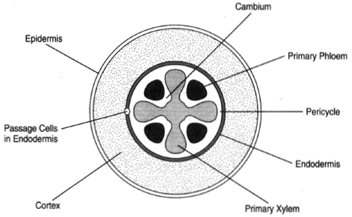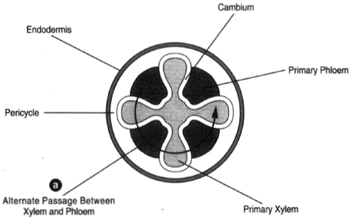Structure of a Root
Figure 33-4 shows a cross section of a root in a region where only primary
growth has occurred. All tissues here derive from apical meristem. The inner most,
star-shaped tissue is the primary xylem. Between the points of the
primary xylem are areas of primary phloem. Immediately outside of these
primary vascular tissues is a zone of parenchyma cells, called the
pericycle.
This is bounded by a layer of suberized cells one cell in thickness and called
the
endodermis. Peripheral to the endodermis is another zone of parenchyma
cells known as the cortex. The cortex is bounded on the outside by
the epidermis.
Figure 33-5 shows there to be a region in the root where one may trace
a circlet hat will pass alternately through primary xylem and primary phloem.
This alternating arrangement of the primary xylem and primary phloem is
one of the principal differences between roots and stems.
 |
| Figure 33-4 Cross section of a root exhibiting no secondary growth. The position of the
cambium lies between the primary tissues. (b) Passage cells lie in the endodermis. |
 |
| Figure 33-5 Portion of a root exhibiting only primary growth and lying within the
endodermis. A circle traced as shown at (a) passes alternately through primary xylem
and primary phloem. Only a root exhibiting no secondary growth possesses this
configuration. |






